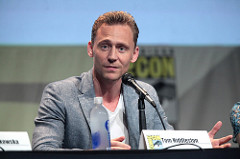Share This Article:
Return to Silver Screen Central Home page


Chris Evans is all smiles after looking at Captain America’s box office totals
BLess that two months ago, Warner Brothers pitted the two greatest heroes in the DC Comics universe against each other in Batman v Superman: Dawn of Justice. Not to be outdone, Disney and the Marvel superheroes have fired back, and the result is a knockout. Not only does Captain America: Civil War have many more superheroes than does its DC counterpart, it has something much more important: a sense of humor.
Civil War has a detailed and, at times, cumbersome plot that basically serves as a device to eventually pit most of the superheroes in the Marvel universe against each other. After several civilians are killed when Captain America (Chris Evans) stops terrorists in Africa from stealing a biological weapon, the United Nations wants to put the Avengers under its direct control. The Captain refuses, and when it later appears that his friend, the Winter Soldier (Sebastian Stan), is responsible for a mass bombing, Iron Man (Robert Downey Jr.) heads up a team of Avengers to bring the Soldier in, even if it means taking on Captain America to do so.
Captain America: Civil War is divided in two roughly equal halves: brooding and fighting. The movie acknowledges the enormous amounts of collateral damage resulting from the finale showdowns in previous Marvel films, and several of the heroes, most notably Iron Man, are wracked with guilt about their involvement. But, much as in Batman v Superman, it’s hard for audiences to take this as anything other than a means to a spectacular end. And the end is truly spectacular, a terrific battle royal pitting a dozen heroes against each other in and above a commercial airport runway setting that conveniently allows them to toss jets at each other with no innocent bystanders in the middle. The two most noteworthy participants in the battle are a new, actually high-school-aged Spider-Man (Tom Holland), and an easygoing Ant-Man (Paul Rudd), who reconfigures his suit to turn himself into a giant. There’s a light touch to the showdown, and, indeed all the set pieces, as directors Anthony and Joe Russo keep the quips flying along with the fists in all the action scenes. Just as important, they made a wise choice in centering Captain America around the more optimistic and youthful appearing Evans rather than the more world-weary Downey. The movie still feels a bit bloated and slow moving at times, but Captain America: Civil War is easily the most effective and entertaining of the Marvel superhero ensemble movies.
Continue reading on Captain America: Civil War: Mini-review


Recent Comments